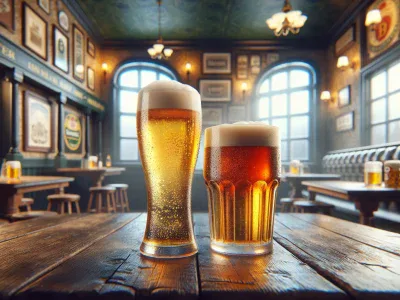Pilsner vs Lager: Understanding the Key Differences Between These Popular Beer Styles
Imagine holding a frosty glass of golden beer, its crisp aroma wafting through the air as tiny bubbles race to the surface. You take a sip, and the refreshing bitterness dances on your tongue. But wait—was that a Pilsner or just a Lager? If you’ve ever wondered about the subtle yet significant differences between these two beer styles, you’re not alone.
Both Pilsners and Lagers share a common ancestry, yet they’re worlds apart in flavor, aroma, and character. One boasts a bold, hoppy personality, while the other leans toward a smoother, more balanced profile. Understanding what sets them apart not only enhances your appreciation for beer but also helps you choose the perfect brew for any occasion. So, whether you’re a casual drinker or a craft beer enthusiast, diving into the nuances of Pilsners and Lagers will elevate your beer experience like never before.
What Are Lagers?
Lagers are a category of beer produced using bottom-fermenting yeast at cooler temperatures, typically 35-50°F (2-10°C). This process results in smooth, clean flavors that distinguish lagers from other beer styles.
Key Characteristics of Lagers
- Fermentation Method: Lagers use Saccharomyces pastorianus, a bottom-fermenting yeast that thrives in low-temperature brewing. This yeast fermentation minimizes fruity esters and strong aromas.
- Flavor Profile: Lagers feature balanced flavors with malt-forward notes, ranging from sweet to bready or slightly toasted. Unlike ales, lagers lack prominent hop bitterness and emphasize drinkability.
- Appearance: Lagers present a clear, filtered appearance, spanning pale yellow to deep amber colors, depending on the specific type.
- Carbonation: These beers are more carbonated, providing a crisp mouthfeel that complements their light-to-medium body.
- Pale Lager: Known for light golden hues and mild, refreshing flavors. Popular examples include Heineken and Budweiser.
- Amber Lager: Offers richer malt characteristics with caramel undertones. Notable brands are Samuel Adams Boston Lager and Dos Equis Amber.
- Dark Lager: Exhibits chocolate or roasted malt flavors with dark brown or nearly black color. Models include Warsteiner Dunkel and Negra Modelo.
- Vienna Lager: Features a reddish-brown appearance and toasty malt flavors, as found in Modelo Especial.
Lagers cater to a range of tastes, suiting casual drinkers and enthusiasts alike.
What Is a Pilsner?
A Pilsner is a type of Lager known for its crispness, golden color, and pronounced hop flavor. It represents a specific style within the larger Lager family, setting itself apart through its unique brewing process and taste profile.
Key Characteristics of Pilsners
Pilsners have distinct traits that differentiate them from other beers. Their light body and bright, golden hue make them visually appealing. The flavor is defined by noticeable bitterness and a refreshing finish, thanks to the use of noble hops such as Saaz, Tettnang, or Hallertauer. These hops contribute herbal, floral, and spicy notes, balancing the malt sweetness.
Carbonation levels are high, creating a lively mouthfeel. Alcohol-by-volume (ABV) ranges between 4.2% and 5.8%, depending on the variant, maintaining their easy-drinking nature. Compared to most Lagers, Pilsners lean towards a drier and more bitter finish.
Example beers include Czech Pilsners like Pilsner Urquell and German Pilsners like Bitburger. Modern craft breweries, such as Firestone Walker and Victory Brewing Company, also produce American takes on the style.
Origins of Pilsner Beer
The Pilsner style originates from Plzeň (Pilsen), a city in what is now the Czech Republic. It was first brewed in 1842 by Josef Groll, a Bavarian brewer, using bottom-fermenting yeast. He utilized the region’s soft water, pale malts, and Saaz hops to create a beer that contrasted the darker, heavier Lagers of the time.
Pilsner became an instant success and inspired similar brews across Europe. German brewers adapted the style, emphasizing hop bitterness, while others in the U.S. and beyond created variations tailored to local preferences.
The influence of Pilsner is evident in its global popularity, with its brewing methods, ingredients, and flavor profile forming the blueprint for many modern beer styles.
Key Differences Between Pilsner and Lager
Even though originating from the same lager family, Pilsners and Lagers offer distinct characteristics that set them apart. From flavor nuances to brewing techniques, the differences cater to unique preferences.
Flavor Profiles
Lagers provide a smoother, malt-forward taste with minimal hop bitterness. For example, a Pale Lager may have subtle grainy flavors and a slightly sweet finish. In contrast, Pilsners exhibit a bolder flavor and more pronounced bitterness due to the use of noble hops, such as Saaz or Tettnang. These hops deliver herbal, floral, and peppery notes, creating a sharper and dryer profile.
While Lagers aim for balance, Pilsners lean towards showcasing aromatic hops combined with a crisp, refreshing palate. This distinction makes Pilsners feel more vibrant, where Lagers come across as versatile and easier-going for broader drinker appeal.
Brewing Process
Both Pilsners and Lagers use bottom-fermenting yeast. But, Pilsners require more precise handling of noble hops during the brewing process to achieve their signature bitterness and aromatic qualities. For instance, Pilsners typically undergo a longer maturation period at cooler temperatures, allowing flavors to develop further.
Lagers involve a simpler approach, focusing on clean fermentation to minimize fruity esters. This technique results in a clean and smooth body, ideal for rendering traditional styles like Munich Helles or Vienna Lager. While both are refined processes, Pilsner brewing places more emphasis on hop character and aroma manipulation.
Appearance and Color
The appearance of Pilsners and Lagers reflects their flavor profiles. Lagers cover a broader spectrum of colors, ranging from pale yellow to deep amber or even near-black, as seen in Dark Lagers. Pilsners maintain a golden or straw-yellow hue, accompanied by a bright clarity that emphasizes their freshness.
Pilsners often feature a dense, white head that enhances their aromatic attributes, while Lagers may show varying foam retention depending on the type brewed. This visual distinction can make it easier for you to identify your choice in a lineup of beers.
Alcohol Content
Alcohol content in Lagers and Pilsners shows subtle variation. Lagers typically range from 4% to 6% ABV, depending on the substyle, with beers like Amber or Dark Lager leaning toward the higher end. Pilsners exhibit a slightly narrower ABV range, from 4.2% to 5.8%, reflecting their crisp and sessionable nature.
Stronger Lagers like Doppelbocks can exceed 7% ABV, highlighting the diversity within the Lager category, whereas Pilsners generally prioritize balance, making them less intense in terms of alcohol strength.
Popular Examples of Each Style
Understanding examples of Pilsners and Lagers enriches your knowledge of these beer styles. Both categories showcase diverse offerings across global breweries.
Notable Pilsner Brands
- Pilsner Urquell: Originating in the Czech Republic, this iconic brew defines the original Pilsner style, featuring crisp, floral notes from Saaz hops. Its golden color and clean bitterness make it a classic choice.
- Bitburger Pilsner: A German variation delivering a dry finish, moderate hop bitterness, and subtle malt sweetness, maintaining tradition with Tettnang and Hallertauer hops.
- Victory Prima Pils: A balanced American Pilsner brewed with European malts and noble hops, exhibiting a vibrant floral aroma and punchy hop profile.
- Weihenstephaner Pils: Produced by the world’s oldest brewery in Germany, this Pilsner offers a smooth body with herbal undertones and consistent carbonation.
- Lagunitas Pils: A California craft favorite combining Czech influences with a hoppy twist, resulting in bold, spicy tones.
- Budweiser: A globally recognized pale lager with light malt sweetness and a smooth profile, brewed using rice for a distinctive flavor.
- Heineken: This Dutch lager presents a clean taste, mild bitterness, and subtle fruity esters, adhering to European standards.
- Yuengling Traditional Lager: America’s oldest brewery produces this amber lager marked by roasted caramel malts and mild hop essence.
- Estrella Damm: A Spanish classic with a refreshing balance of malts, hops, and a slightly sweet finish, ideal for warm climates.
- Spaten Münchner Hell: A Munich Helles lager offering soft malt flavors, low bitterness, and a creamy texture, true to Bavarian brewing heritage.
Both styles boast a range of profiles appealing to different palates, whether you prefer the hop-forward crispness of Pilsners or the smooth, malty character of Lagers.
How to Choose Between a Pilsner and a Lager
When deciding between a Pilsner and a Lager, consider the context in which you’ll be enjoying the beer. Personal preferences and food pairings are key factors in making the choice.
Personal Preferences
Think about whether you prefer bold, hoppy flavors or smooth, malty notes. Pilsners, with their prominent bitterness and floral or spicy hop character, appeal to those who love vibrant, crisp beers. Examples like Pilsner Urquell or Victory Prima Pils highlight these qualities.
If a more balanced, malt-forward taste fits your palate, Lagers may be the way to go. Classic options like Budweiser or Spaten Münchner Hell offer clean, mellow profiles without intense hop aromas. The wider color and flavor range of Lagers caters to various tastes, from the light, refreshing Pale Lager to the richer Amber or Dark Lager styles.
Pairing with Food
Match the beer’s flavor spectrum with your meal. Pilsners’ bitterness and dry finish work well with spicy dishes, grilled seafood, or tangy cheeses. For instance, a Saaz-hopped Pilsner pairs effectively with Thai curry or smoked salmon, balancing the spice or complementing the smoky undertones.
Lagers, with their smooth and subtle flavors, pair seamlessly with hearty foods like burgers, roasted chicken, or pizza. A Vienna Lager can enrich roasted pork dishes, while a Dark Lager’s malt complexity enhances BBQ or chocolate desserts. Selection depends on whether you desire contrast or harmony in your food pairing.
Conclusion
Understanding the differences between Pilsners and Lagers allows you to fully appreciate their unique qualities and choose the perfect beer for any occasion. Whether you’re drawn to the crisp, hoppy bite of a Pilsner or the smooth, malt-forward character of a Lager, both styles offer something special for your palate.
Exploring these beer varieties not only enhances your knowledge but also helps you discover new favorites to enjoy. So next time you’re selecting a brew, consider the distinct flavors, aromas, and characteristics that set these two styles apart. Cheers to finding your perfect pint!
- LVP Versus Engineered Hardwood: A Comprehensive Comparison - November 15, 2025
- Understanding Identity versus Role Confusion - November 15, 2025
- Xbox Versus PlayStation: A Comparative Analysis - November 15, 2025






